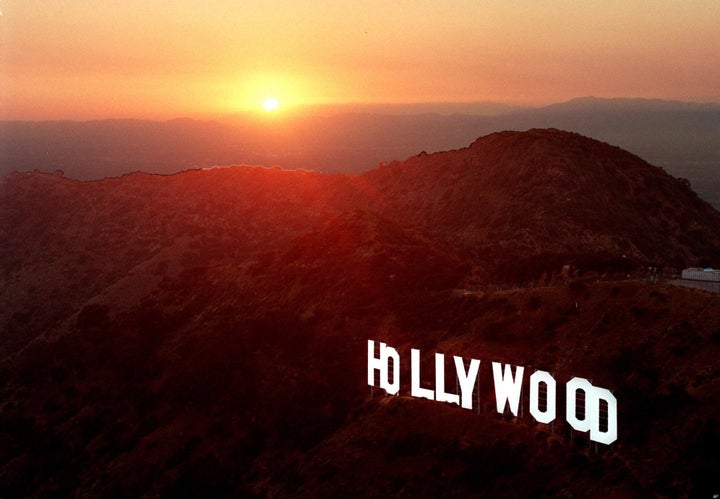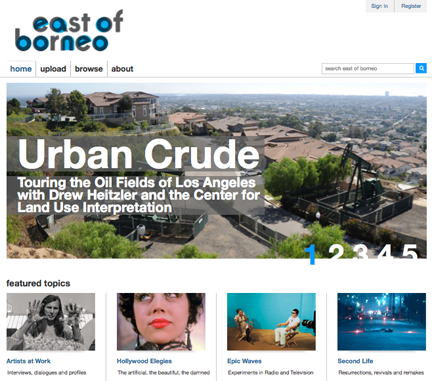
In Los Angeles, where over two hundred languages are spoken in the elementary schools alone, with a diversity of just about everything you can think of, it's almost impossible to imagine a dominant history encompassing this sprawling heterogeneous city. With so many individual perspectives here, it's worth asking who gets to write the dominant narrative, who gets to tell the tale of Los Angeles? How is the story of L.A. going to change as the times change? And how will the story of art history change too? Perhaps East of Borneo, a new art publication, can help frame this debate and shape a new model for the future of art publications.
East of Borneo is an innovative online publication devoted to charting visual culture in L.A. It's published by California Institute of the Arts (CalArts), where the Editor in Chief, Tom Lawson is the Dean of the Art School. The title comes from a film made in 1931 which has it's own history of re-cutting and appropriation. It's an imaginary tale of a place, just like Los Angeles, which is propelled into the future by an industry that runs on imagination. There is a rich cultural history and astounding diversity here -- if you are willing to look closely -- but the dominant narrative often overshadows some of the most interesting things about the place.
This new publication marks the convergence of two very distinct lines of thought. What are the nature and the future of art magazines? And how might we give form to the sprawling history of art in Los Angeles, a form that can be generative and productive, not merely descriptive or fancifully speculative? Art publications come and go, and East of Borneo has just arrived. Will this model change the face of future art publications? Will this art publication have a long life and sustain its longevity? Who participates may answer this question.
East of Borneo's online presence follows many other online publications in that it hosts writings by some of the art world's most inspirational thinkers, but it also involves a platform that allows readers to participate in the generative collective understanding of the publication's texts. Readers are invited to submit their own links, images or videos that respond to existing articles, as well as inviting submissions. Writers can also include navigable footnotes or images from their own research in the articles they write. Since we are all asked to participate, it opens the doors to a wide variety of opinions, and readers are no longer relegated to the comments section.
East of Borneo is an intricately interwoven site that allows the editors to build an archive of Los Angeles, past and present, using the power of a networked collectivity to create depth and complexity. As you navigate the site you will discover that East of Borneo incorporates the benefits of online media for the sharing and distribution of research and archival material, some of which has not previously been available online. Articles incorporate and offer readers immediate access to materials -- video, images, links and texts -- that the writers have used in their research, and readers can upload additional items that activate and enrich the editorial material, as well as provide a depth of coverage that can be extended as long as there are contributions.

East of Borneo, a new online publication
Los Angeles has a variety of histories informed by multiple points of view. Since artists have a very different viewpoint from museum directors, who have a different perspective than, say, gallerists, who have a different outlook than collectors, who have different view than art movers, gallery visitors, etc, it's interesting to think of all these viewpoints converging on one site. Historians create histories, where most of us are the readers of those histories. Art magazines have been no exception, and have also created hierarchies with writers and readers. So what are the multiple points of view in L.A.? East of Borneo is slated to address this issue on an international level.
East of Borneo is not just about Los Angeles, but a view from Los Angeles. It will respond to events and exhibitions that inform an understanding of LA. Not only will it cover the art market, but, refreshingly, it will also look at alternative practices from the past as well as current practices and strategies. The publication also plans to report on some really important and intriguing archives owned by Los Angeles residents, and folks from other locals. Lets hope they make it to this new magazine and not kept hidden under layers of web pages, or inaccessible to all but the most die hard scholars who have access to museums or other archive collections. Los Angeles has a history of trailblazing art publications. Artforum began here. Other magazines such as X-tra and Artillery are still around, but most have gone into the dustbins of history. In an era of short blogs and superfluous reviews, the idea of a well-rounded and in-depth investigation that is the result of many voices is a welcome addition to the contemporary art discourse.
Initial content includes essays and or interviews with Drew Heitzler, Center for Land Use Interpretation, Mark Allen and George Herms, Ingrid Calame and James Welling, Don Bachardy, early work by Chris Burden and Harry Gamboa. As well as reconsiderations of Roger Corman's seat of the pants film making, a look at the 70s sitcom, Mary Hartman, Mary Hartman and a little essay on Brecht in LA. Everything that is posted is new; some contributions are a decade old. As an archive, we may learn some new aspects of an artists' practice that have been ignored, or new insights into a career that is much older. We might even discover artists, curators or organizers who have been important to the history of Los Angeles but are no longer in the spotlight.
Many archives are housed in museums or other locations and are only accessible to scholars. Many people in Los Angeles own a wealth of materials on the history of art in Los Angeles that can be added to the site. Got a collection of photos from the 60's art scene? Own a video about an artist talk from the 70's? You have a chance to share this via East of Borneo and share it with the public. Users can upload additional items, creating a growing archive of relevant content that activates and enriches the editorial material. Topics will continue to develop over time as material accrues, becoming substantial repositories of information and interpretation from a multitude of perspectives. One of the interesting questions that comes up will be who will share their materials? Archives are worth a lot of money these days, and are kept under lock and key. And who will own these materials once they are uploaded onto the site? Will it be considered "fair use" or belong to the person who uploads it?
The success of this project will be based on its use. Who contributes will craft the sensibility of this online experiment, and it might as well be you. Tom Lawson sums it up this way: "Our aim is to be an open, user-friendly access point. My ultimate fantasy is for the site to be a giant web of information that is the indispensable source for information about art in LA, the place anyone would come to browse or really study, find the raw archival material, and also interesting and illuminating commentary, so that new narratives can be constructed."
This far-reaching project will also include an imprint of highly focused books that reconsider neglected material and provocative themes within a contemporary context. The first, to be published in early 2011, will present the selected writings of architecture critic Esther McCoy, edited and with an introduction by writer Susan Morgan. It will be interesting to see just what kinds of content are supported by this new endeavor, and what actually makes it into print.
What is exciting about this project is the potential to expose a multitude of narratives on the art and artists of Los Angeles, the history of its art institutions, as well as obscure and relevant information. Since art history is shaped by gatekeepers who delineate fine art from craft, high from low, insiders from outsiders, the chance to participate in this collective understanding of history will generate narratives that may change the face of what we now consider to be the history of art in Los Angeles. Writers can finally include information on their research in a variety of ways. Readers can upload contributions that relate to each article, which may or may not support the perspective of the writer. Those that have been left out of the dialog in print or history, may find a voice here. Perceptions just might get corrected from multiple points of view. There are a number of fairly well known artists who are not going to be a part of the Getty-initiated Pacific Standard Time series of exhibition slated to begin in 2011. Perhaps East of Borneo can help round out those other stories.
Multiple narratives are always more interesting. So what is the future of art magazines? East of Borneo aims to find out.
Karen Atkinson is an artist who is the founder of Getting Your Sh*t Together (GYST Ink), an artist run company that supports artists through information and services, and a faculty member of CalArts. http://www.gyst-ink.com